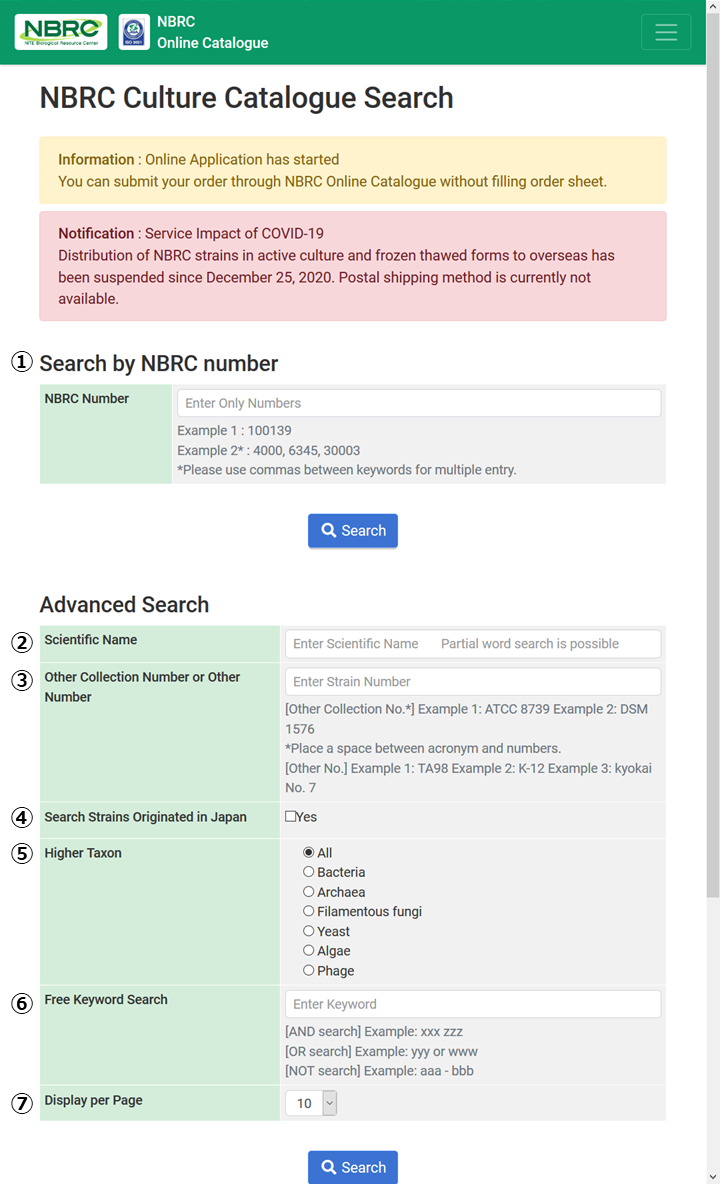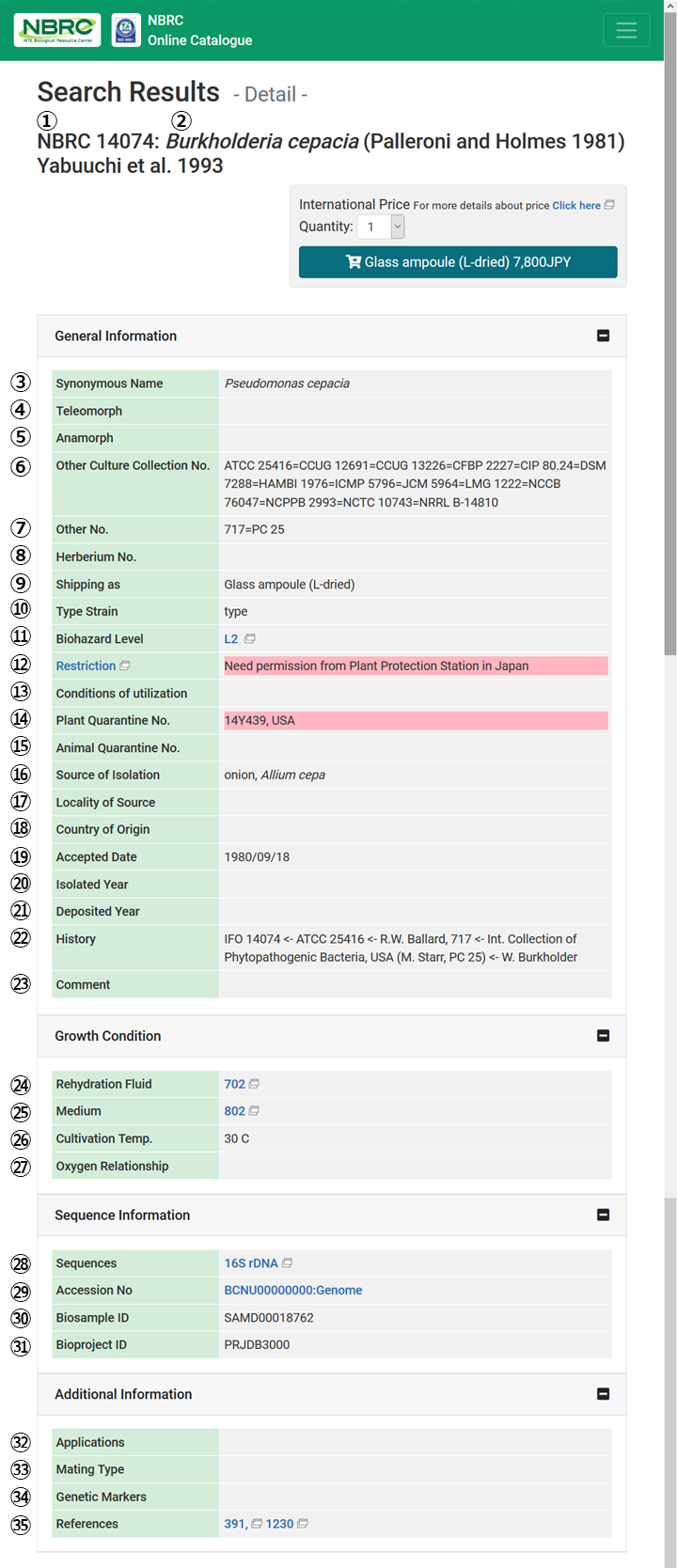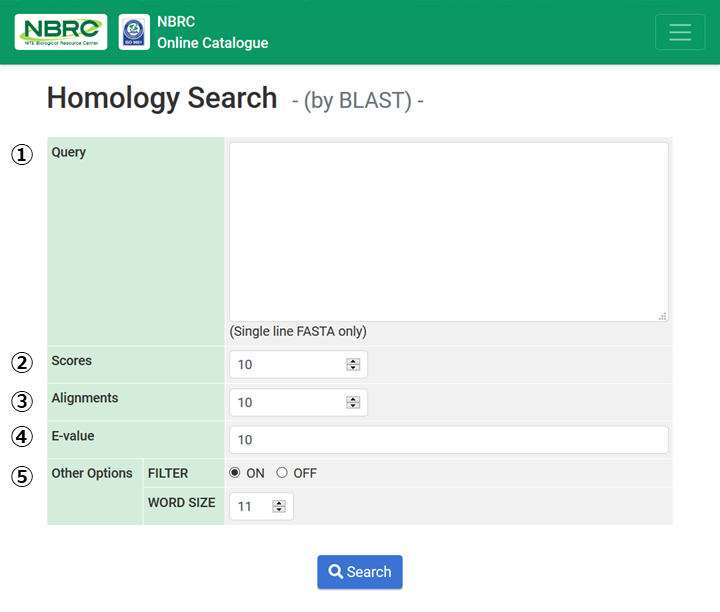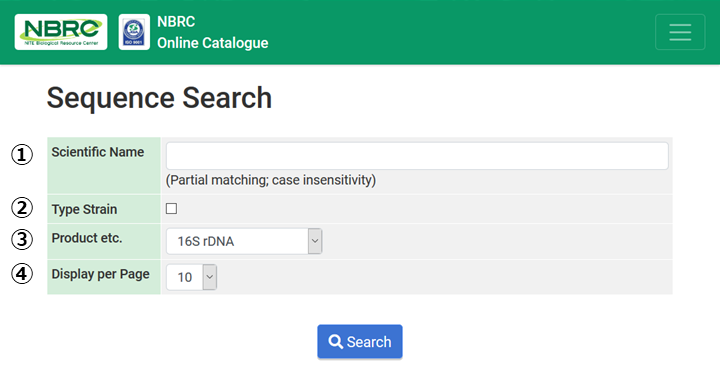About NBRC online catalogue
NBRC Online Catalogue is a database system of NBRC culture collection. You can search information of NBRC strains such as strain number, scientific name, source of isolation, country of origin and sequence data. Homology search with BLAST is also available to find NBRC strains.
Furthermore, the items you wish to purchase can be ordered from NBRC Online Catalogue.
NBRC Culture Catalogue Search
You can search NBRC strains by any of the following search queries.
| Search by | |
|---|---|
| 1. NBRC No. | Enter a NBRC strain number (1 to 8 digits). IFO numbers may also be queried because IFO strains have been transferred to the NBRC using the same identification numbers (e.g., IFO 3972 = NBRC 3972). |
| 2. Scientific Name | Genus, species and lower taxonomic units are in bold, followed by the author name(s). |
| 3. Other Collection Number or Other Number | Enter the abbreviation of culture collections followed by a single space and the unique number (e.g., MBIC 10229) to search for the strains derived from the same origin. For the IFO strains, use the top search field. Abbreviation for culture collections are listed in the PDF [PDF:113KB] file. |
| 4. Search Strains Originated in Japan | Check the box to limit the search result for originated in Japan. |
| 5. Higher Taxon | |
| 6. Free Keyword Search | Enter any words to search all the fields of our online catalogue. |
| 7. Display per Page | Display the list of all bacterial phage strains. |
Catalogue Detail Information
Our online catalogue shows the following information for each strains.
| 1. NBRC No. | Unique identifier of the strain in the NBRC. | 19. Accepted Date | The date when the strain was accepted by the Institute for Fermentation, Osaka (IFO) or NBRC. |
|---|---|---|---|
| 2. Scientific Name | Genus, species and lower taxonomic units are in bold, followed by the author name(s). | 20. Isolated Year |
The date when the strain was isolated. |
| 3. Synonymous Name(s) | Synonyms, and anamorphic and teleomorphic names for eukaryotes. | 21. Deposited Year | The date when the strain was deposited with the Institute for Fermentation, Osaka (IFO) or NBRC. |
| 4. Teleomorph | The sexual (perfect) state of an ascogenous or a basidiogenous fungus. | 22. History | Record of transfers of the strain before it was deposited to the NBRC. |
| 5. Anamorph | The asexual (imperfect) or conidial state of a fungus. | 23. Comment | Other information |
| 6. Other Culture Collection No. | Other strains isolated from the same origin and preserved in other WFCC-member culture collections. Abbreviation of other culture collections and institutes are shown in this PDF file [PDF:113KB]. | 24. Rehydration Fluid | Solvent to use to rehydrate the L-dried strain (preserved through liquid-drying and shipped in glass ampoules). |
| 7. Other No. | Other strain number(s) used by researchers and/or culture collections that are not registered in the WFCC. | 25. Medium | Recommended medium for cultivation. |
| 8. Herbarium No. | Unique specimen identifier of the strain when relevant. See the Index Herbarium for abbreviations. | 26. Cultivation Temp. | Recommended temperature for cultivation. |
| 9. Shipping as | Product Format | 27. Oxygen Relationship | If blank, the strain is an aerobe or a facultative anaerobe. |
| 10. Type Strain | The taxonomic classification of the strain/ex-type strain (including ex-type of synonyms in eukaryotes). | 28. Sequences | DNA region(s) analyzed and published by the NBRC. |
| 11. Biosafety Level | BSL indicates the pathogenicity of the strain to humans. Blank means BSL 1. We do not provide strains that have been classified as BSL 3 and 4. | 29. Accession No. | The numbers registered with INSDC, the International Nucleotide Sequence Databases Collaboration. |
| 12. Restriction | * See below column. | 30. BioSample ID | https://www.ncbi.nlm.nih.gov/biosample/ |
| 13. Conditions of utilization | The Terms and Conditions set by depositor. | 31. BioProject ID | https://www.ncbi.nlm.nih.gov/bioproject/ |
| 14. Plant Quarantine No. | Japanese Plant Quarantine (JPQ) number and exporting country are shown when relevant. If this number is shown, permission from JPQ is necessary before ordering if this will be used in Japan. | 32. Applications | Known products and applications of the strain. |
| 15. Animal Quarantine No. | Japanese Animal Quarantine number. | 33. Mating Type | Sexual compatibility (i.e., homothallic / heterothallic, +/-, A/a) to eukaryotes. |
| 16. Source of Isolation | Source material that the strain was isolated. | 34. Genetic Marker | |
| 17. Locality of Source | The place where the source was collected. | 35. References | Published reports about the strain. |
| 18. Country of Origin | Country or national domain where the microbe was collected. |
NBRC Culture Homology Search
Sequence homology search against all the sequence data of the NBRC strains and the INSD (International Nucleotide Sequence Database) for bacteria, archaea, algae, fungi and yeasts.
| Entry field | |
|---|---|
| 1. Query Sequence | Enter a nucleotide sequence here to search. Do not enter multiple sequences. |
| 2. Scores | Enter the maximum number of BLAST hits to display. |
| 3. Alignments | Enter the maximum number of aligned sequences against your query to display. |
| 4. Expect | Enter a value close to zero to minimize the search result (for advanced users). |
| 5. Other options | If set to -N 0 (zero), you can limit the database to NBRC strains. Advanced settings for the homology search are available as implemented in BLAST of the DDBJ. More details are available at the DDBJ web site. |
NBRC Culture Sequence Download
Enter a scientific name to obtain all the sequences of the species deposited in the NBRC. The results will be shown in multiFASTA format and are downloadable.
| Search by | |
|---|---|
| 1. Scientific name | Enter a scientific name. A partial name is accepted by the search system because it has been designed to conduct a prefix search. Synonyms will also be searched as long as these have been registered in our database. Abbreviation of a genus name (e.g., E. coli) and common names are not supported by the system. |
| 2. Type Strain | Check the box to limit the results for type strains (taxonomic type strains, including ex-types). |
| 3. Product etc. | Choose a DNA region from the pull-down menu. |
| 4. Display per Page | |
Contact us
- Culture Collection Division, Biological Resource Center, National Institute of Technology and Evaluation
-
Phone number:+81-438-20-5763
Address:2-5-8 Kazusakamatari, Kisarazu-shi, Chiba 2920818, Japan MAP
Contact Form






